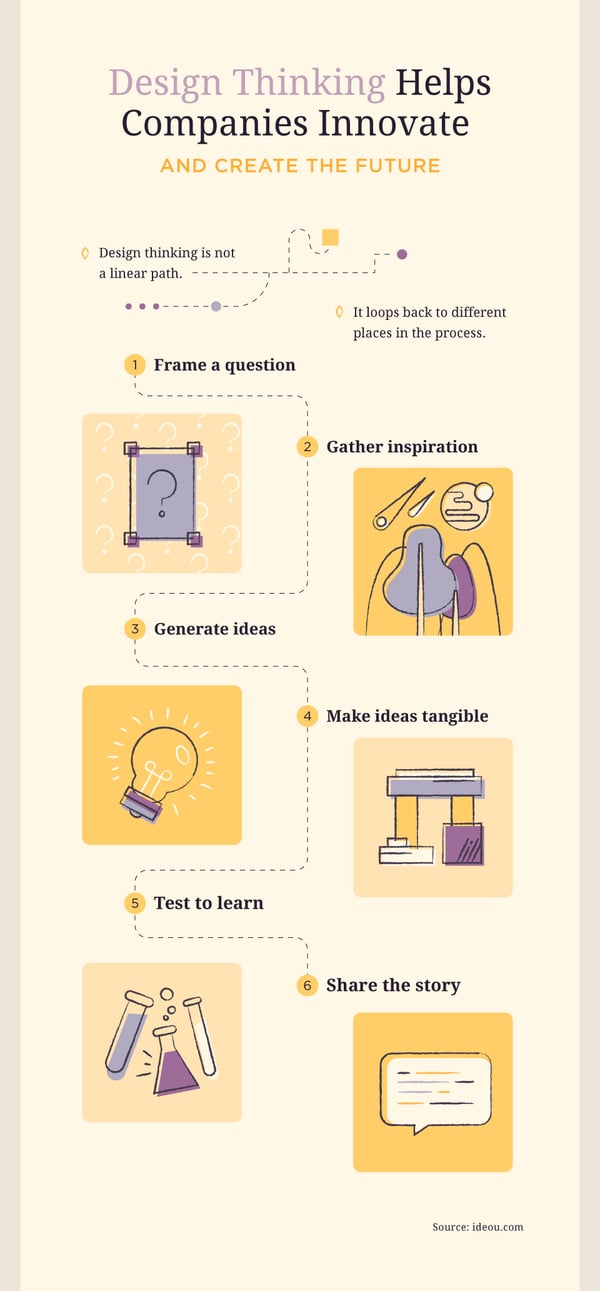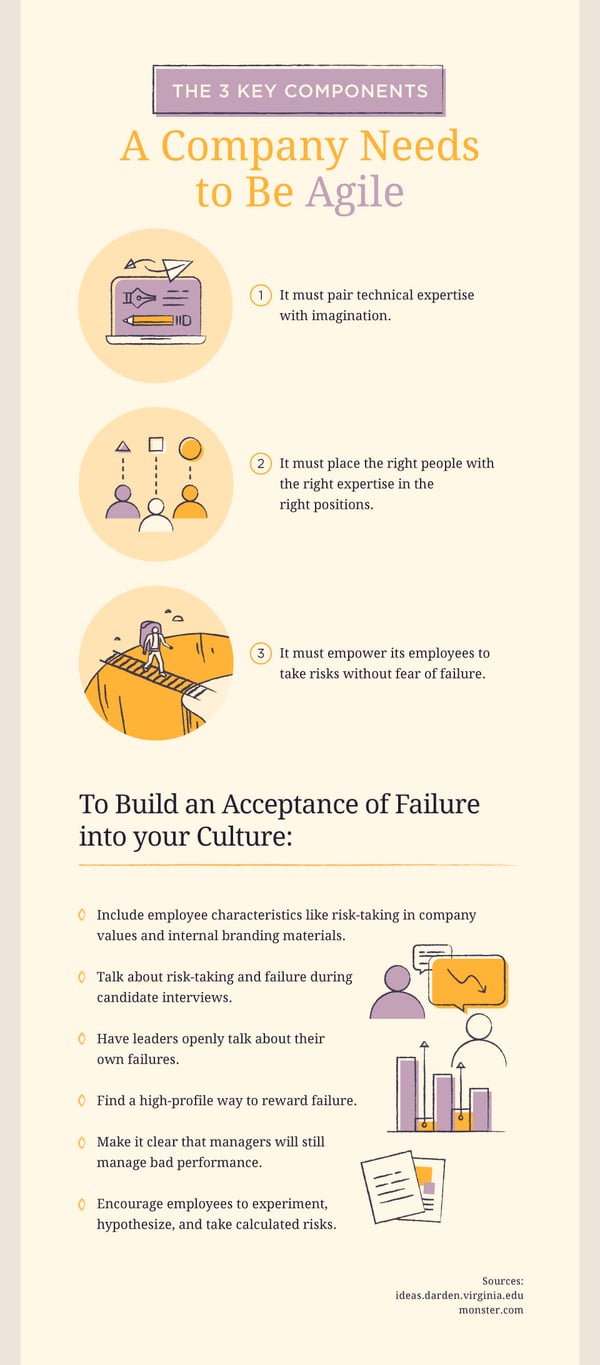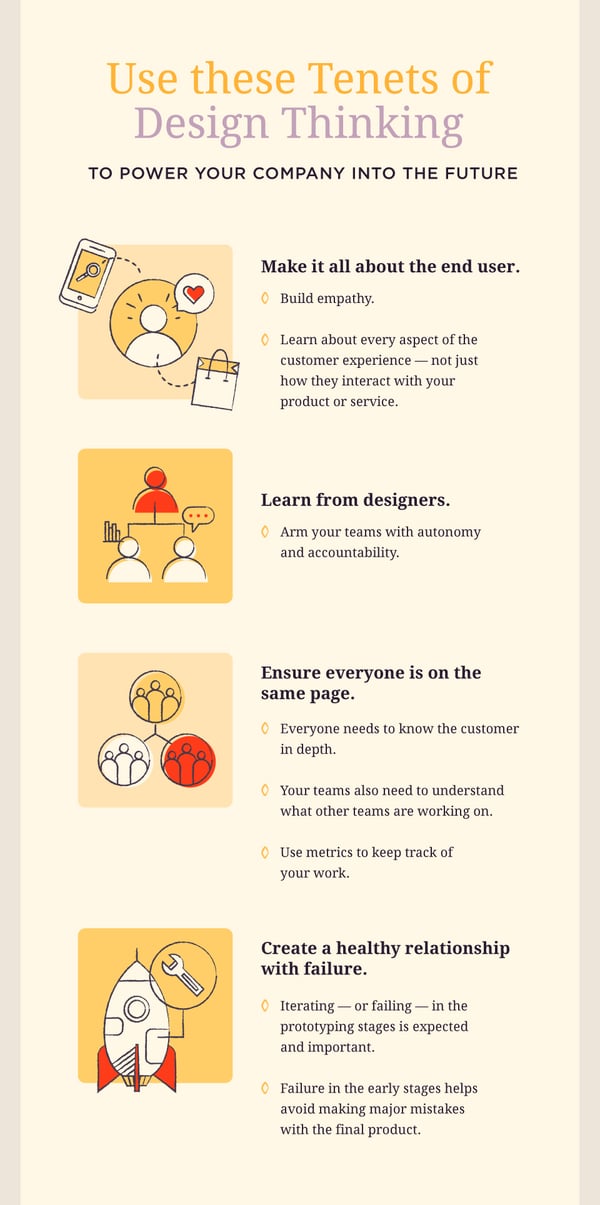How to Use Design Thinking to Become Future-Ready
When a company doesn’t keep up with what customers want and demand, it can flounder. Mobile customers want touchscreens and apps, but a company creates phones with small screens and tactile keyboards. People want to watch the shows they like on-demand, but the provider only allows the show to be watched at a certain day and time, and they are interrupted by commercials. Consumers want interesting or entertaining content on social media, but companies post ads.
What makes all this even more difficult is that consumer demand changes, often unpredictably and quickly. Companies must be able to react. The most successful companies, however, do more than react; they understand their customers well enough that they can innovate for their future needs.
In fact, with the right research and analysis, strategies and approaches to innovation, problem-solving and customer-centricity, these companies do better than react — they are future-ready, and their customers happily reap the benefits.

How Can a Company Prepare for the Future?
Baba Prasad is the CEO of the Vivékin Group, a management consulting firm. He wrote Nimble: Make Yourself and Your Company Resilient in the Age of Constant Change, and was interviewed by the Knowledge@Wharton Podcast. In the interview, he shares that no one knows what the future holds. For that reason, companies must rely on strategies that develop “capabilities that can allow us to handle different situations that may evolve.” Companies unable to evolve or react will find it difficult to stay relevant in the market.
The business world describes this ideal type of company in a few ways: agile, nimble, forward-thinking, future-ready, innovative. But what does any of that really mean? And how can a concept like design thinking help a company excel?
To be nimble, use agile methods combined with the power of design thinking.
A nimble company can make changes quickly. It can switch gears without suffering huge losses and avoids siloed departments and teams in order to be more efficient. Sean Carr, the Executive Director of the Batten Institute for Entrepreneurship and Innovation at the University of Virginia, writes that three components must be in place in order for a company to be agile.
-
It must pair technical expertise with imagination.
-
It must place the right people with the right expertise in the right positions.
-
It must empower its employees to take risks without fear of failure.
An agile company will have the benefit of moving fast and iterating on products and services to keep up with demand. When coupled with the power of design thinking, it is an excellent way to make sure your company or organization is future-ready.
Design thinking is a powerful method for understanding the needs and demands of your customers. Along with agile practices, you’ll be able to execute the ideas and concepts discovered from your customer learnings much more quickly.
1. It’s all about the end user.
When you tune in to your customers’ needs, you can better meet and exceed their needs and wants. This goes beyond the basics of finding a problem, then offering a solution. It means fully understanding your customer. Spend the time and effort to conduct interviews and step into their shoes. Build empathy. Learn about the entire customer journey, not just the experience your customer has with your product.

For example, Parkinson’s disease affects one in every 500 people in Canada, and those with it may experience tremors. This can cause difficulties with eating: It can be a slow, messy, frustrating process for people who cannot control their movements. Thanks to innovative thinking that originated with camera and sensitive equipment stabilisation, and with advice from a neurologist who specializes in movement disorders including Parkinson's disease and tremors, technologically advanced utensils are now available. The neurologist, Dr. Jill Ostrem, explains, "I have some patients who couldn't eat independently; they had to be fed. And now they can eat on their own. It doesn't cure the disease — they still have tremor — but it's a very positive change."
The power of design thinking is in its ability to change the lives of end users. It can be in an entertaining way, such as Netflix’s introduction of on-demand, streaming content. But in instances like this, in which innovation of utensils gives people more independence, the result can truly be a benefit to society.
2. To use design thinking, learn from designers.
Design thinking is about using imagination, research, and knowledge to create a solution for a problem — sometimes this solution is for a problem customers weren’t even aware they had or could fix. This kind of strategic thinking requires cross-functional teams that include designers, or at least people with design thinking expertise.
Arm these teams with autonomy and accountability. Autonomy is a popular buzzword, but when implemented incorrectly, it can cause a team to work in a silo and potentially in the wrong direction. Instead, make sure they are held accountable to other teams and to the project. An autonomous team can still work independently, just in a focused direction.
As you create these teams, bring design and technology together to co-create options. Perhaps one comes up with a solution they think is impossible, only to learn that with a little effort and practice, it can be achieved. For example, Netflix aimed to bring movies directly to the consumer. Once it harnessed the power of the internet, its options blew wide open, and the result upended industries that seemed to be on solid footing, including cable television, television programming, movie rental stores, and movie theaters.
Finally, once you’ve successfully created these teams and given them a direction, get out of the way. Give them space to ideate, create, iterate, and start over when they need to.

3. Everyone must be on the same page.
In order for design thinking to work, the entire organization needs to know the customer in-depth. It’s a matter of building empathy in every employee in order to keep the customer experience top-of-mind.
If empathy is the foundation of your strategy, that means no one can be unaware of your customers’ lifestyles, needs, aspirations, and struggles.
Additionally, the left hand must know what the right hand is doing. If a designer is creating a mockup of a new app, marketing has created campaigns promising features the designer isn’t aware of, and your developers don’t have the skillset to code what the designer is creating, the project is destined to stumble, be delayed, be rushed, and potentially disappoint the end user.
Get rid of silos and involve your entire organization. Share the insights you get from talking with customers and learning about their headaches and desires. Make everyone part of the discussion. You never know where the next big idea will come from.
To quantify your work, use metrics that focus on the customer. Talk to user experience experts to understand customers’ problems and how they interact with your products. Find the metrics that will show how well you’re improving or create new metrics if you must. In the case of the utensils for patients with tremors, the metric can be as simple as how long it took for a user to eat a bowl of soup. If the time was reduced, that may be your clue that the product is working.
4. Create a healthy relationship with failure.
To let design thinking flourish, you need to promote a rapid prototyping mentality. This way you can quickly deliver products and services, learn more in a shorter amount of time, and go back to the drawing board based on real customer feedback.
In other words, it’s important to design in real time, release fast, and release often in order to prevent costly mistakes. Once you have the process down, your customers will grow to expect great new ideas from your company, which will promote loyalty and profitability.
Design thinking makes an agile company more future-ready.
The key in all this is to foster a culture that promotes taking risks without a fear of failure. With empathy as your guide, data and research at your fingertips, teammates who work together, and management’s support to try anything, your teams will excel at coming up with innovative ideas that will help keep your company ahead of the curve. With design thinking, your employees can help create the future.
Want to learn more about design thinking?
How Design Thinking Creates a Competitive Advantage
Make Your Company Customer-Centric With Design Thinking
Examples of Design Thinking in Action
How Design Thinking Helps Solve Complex Challenges
How to Use Design Thinking to Become Future-Ready